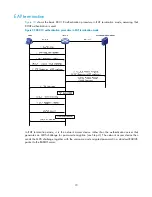
67
EAP relay is defined in IEEE 802.1X. In this mode, the network device uses EAPOR packets to send
authentication information to the RADIUS server, as shown in
.
Figure 29
EAP relay
In EAP termination mode, the network access device terminates the EAP packets received from the client,
encapsulates the client authentication information in standard RADIUS packets, and uses PAP or CHAP
to authenticate to the RADIUS server, as shown in
.
Figure 30
EAP termination
A comparison of EAP relay and EAP termination
Packet exchange method
Benefits
Limitations
EAP relay
•
Supports various EAP
authentication methods.
•
The configuration and processing
is simple on the network access
device.
The RADIUS server must support
the EAP-Message and Message-
Authenticator attributes and the
EAP authentication method used by
the client.
EAP termination
Works with any RADIUS server that
supports PAP or CHAP authentication.
•
Supports only MD5-Challenge
EAP authentication and the
"us password" EAP
authentication initiated by an
HP iNode 802.1X client.
•
The processing is complex on
the network access device.
EAP relay
shows the basic 802.1X authentication procedure in EAP relay mode, assuming that EAP-MD5
is used.
















































